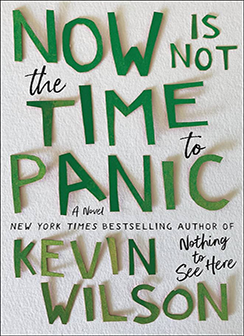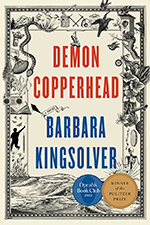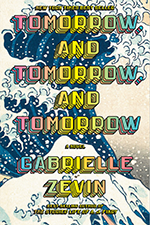 Now is Not the Time to Panic
Now is Not the Time to Panic
by Kevin Wilson
GENRE: Contemporary Fiction, Literary Fiction, Coming of Age
Sixteen-year-old Frankie Budge—aspiring writer, indifferent student, offbeat loner—is determined to make it through yet another sad summer in Coalfield, Tennessee, when she meets Zeke, a talented artist who is as lonely and awkward as she is.
As romantic and creative sparks begin to fly, Frankie and Zeke make an unsigned poster that becomes unforgettable to anyone who sees it. Copies of their work are everywhere in town, and rumours start to fly about who might be behind the ubiquitous posters: Satanists? Kidnappers? Soon, the mystery has dangerous repercussions that spread further afield, and the art that brought Frankie and Zeke together now threatens to tear them apart.
Twenty years later, Frances Eleanor Budge—famous author, mother to a wonderful daughter, wife to a loving husband—gets a call that threatens to upend everything: a journalist asks if Frances might know something about the Coalfield Panic of 1996. Could Frances’ past destroy the life she has so carefully built?
 Author Biography
Author Biography
Kevin Wilson is the author of two collections, Tunneling to the Center of the Earth (Ecco/Harper Perennial, 2009), which received an Alex Award from the American Library Association and the Shirley Jackson Award, and Baby You’re Gonna Be Mine (Ecco, 2018), and three novels, The Family Fang (Ecco, 2011), Perfect Little World (Ecco, 2017) and Nothing to See Here (Ecco, 2019), a New York Times bestseller and a Read with Jenna book club selection. His fiction has appeared in Ploughshares, Southern Review, One Story, A Public Space, and elsewhere, and has appeared in Best American Short Stories 2020 and 2021, as well as The PEN/O. Henry Prize Stories 2012. He has received fellowships from the MacDowell Colony, Yaddo, and the KHN Center for the Arts. He lives in Sewanee, Tennessee, with his wife, the poet Leigh Anne Couch, and his sons, Griff and Patch, where he is an Associate Professor in the English Department at Sewanee: The University of the South. - Author's website
Booklist
If the Coalfield Panic were to happen today, it would dominate the news cycle for 10 minutes before it got subsumed by another, more sensational story. In middle-of-nowhere Tennessee in 1996, Frankie Budge and her new friend, Zeke, create a poster and plaster it all over town as performance art. Unfortunately, the poster catches people's imagination for all the wrong reasons, and it stays in the larger public consciousness for longer than Frankie and Zeke ever wanted. The signature slogan is Frankie's, "The edge is a shantytown filled with gold seekers. We are fugitives, and the law is skinny with hunger for us." To the two teenage misfits in Coalfield, the writing sounds subversive yet safe. But once the narrative gets out of control, it creates serious and lasting damage, enough to cast a long shadow on Frankie's adult life. Wilson (Nothing to See Here, 2020) has developed a story that is a precise capture of adolescence and of two vibrant teens whose everyday dilemmas, weaknesses, and triumphs are utterly endearing. If the denouement feels a little pat, it is more than made up for by the crisp dialogue and the zipping story line that takes us there.
Kirkus
The irrepressible Wilson presents a grunge-era fable about a pre-internet mass-hysteria incident and the alchemy of art. Family dramas and short stories are the author's sweet spots, but for this emotionally acute peek into the inner life of the artist, he's turned to the uncomfortable exile of adolescence. Coalfield, Tennessee, circa 1996 is as remote (and boring) as any rural American outpost, so budding teen writer Frances "Frankie" Budge is intrigued when Zeke, a strange boy from Memphis, shows up at the public pool. "This town is weird," the stranger observes. "It's like a bomb was dropped on it, and you guys are just getting back to normal." In the grip of summer's dog days, Frankie and Zeke pursue their artistic outlets elbow to elbow, hers the written word, his visual arts. Joining forces, they make a poster emblazoned with a throwaway couplet about outlaws on the run: "The edge is a shantytown filled with gold seekers. We are fugitives, and the law is skinny with hunger for us." Soon, they commandeer an old copy machine and plaster the town with their anonymous manifesto, punctuated by inevitable adolescent canoodling. What follows is a rough approximation of the "Satanic panic" of the Reagan-era 1980s, as the media labels the work "troubling street art" before it snowballs into a national hysteria that fortunately exists mostly on the periphery here. Wilson ignores the low-hanging fruit--Frankie and Zeke's relationship is fundamentally a coming-of-age tale, but not in the way you might think. Instead, he focuses on the wonderful, terrible, transformative power of art. The catalyst for Frankie's reluctant confession, 20 years later, is a visit from a New Yorker art critic convinced that Frankie wrote the infamous, trouble-causing line. In a world where art is often dismissed, Frankie will learn whether the line she created still holds the power she'd thought long since lost. A warm, witty two-hander that sidesteps the clichés of art school and indie film and treats its free spirits with respect. Copyright (c) Kirkus Reviews, used with permission.
Publisher's Weekly
Wilson (Nothing to See Here) spins a delightful story of two aspiring artists in small-town Tennessee. It's 1996 when Frankie Bulger, an outcast who dreams of becoming a writer, meets Zeke, also 16, who is new to town. Together they make a poster with the cryptic line "The edge is a shantytown filled with gold seekers. We are fugitives, and the law is skinny with hunger for us." Thrilled at their creation, Frankie and Zeke make hundreds of copies of it on a photocopier stolen by Frankie's triplet brothers, then post them around town. Copycats begin doing the same, and before long, local and national newspapers report on the panic caused by the posters, fashion brands reproduce the slogan on T-shirts, and tourists arrive in droves. Frankie and Zeke keep their involvement a secret until 22 years later, when a journalist finds out Frankie's role. Confronted with the possibility of her secret coming out, Frankie goes on a quest to come clean with her family and reconnect with old friends. Wilson ably captures Frankie and her peers' adolescent confusion and the creative power of like-minded teens, and his coming-of-age story is ripe with wisdom about what art means in the modern age. It adds up to a surprisingly touching time capsule of youth in the '90s. Agent: Julie Barer, Book Group. (Nov.)
Library Journal
Wilson (Nothing To See Here) has been carefully building his literary cachet over the past decade, and he's produced perhaps his most emotionally nuanced and profoundly empathetic novel yet. It tells the story of a 1996 Ohio summer during which two teen outcasts produce a mysterious work of art that instigates a Satanic Panic--style mass hysteria in their hometown simply by virtue of its poetic inscrutability. Wilson appropriates the absurdist foundation of 1980s/1990s moral panic phenomena to cushion his cultural critique, and there's a baked-in nostalgia to the book's aesthetic as he demonstrates a keen understanding of the fickleness of adolescence--how "[we] talked about what we always talked about…trying to adequately explain ourselves to another person"--and particularly how we alternately seek to preserve our formative years in amber and to fast-forward toward their expiration. But rather than leveraging any of this toward shallow buzzword topicality, Wilson meaningfully crafts formed characters, allowing his work to register as a universal document of teenage turmoil as blessedly compassionate as it is cunning. VERDICT Highly recommended as a sincere, sometimes brutal, but always sturdy study of the burden of both art and adolescence and a wonderfully evocative treatise on how we imprint ourselves on the world and learn to survive in that tumultuous wake.--Luke Gorham
 Demon Copperhead
Demon Copperhead
by Barbara Kingsolver
Set in the mountains of southern Appalachia, Demon Copperhead is the story of a boy born to a teenaged single mother in a single-wide trailer, with no assets beyond his dead father's good looks and copper-colored hair, a caustic wit, and a fierce talent for survival. Relayed in his own unsparing voice, Demon braves the modern perils of foster care, child labor, derelict schools, athletic success, addiction, disastrous loves, and crushing losses. Through all of it, he reckons with his own invisibility in a popular culture where even the superheroes have abandoned rural people in favor of cities.
Many generations ago, Charles Dickens wrote David Copperfield from his experience as a survivor of institutional poverty and its damages to children in his society. Those problems have yet to be solved in ours. Dickens is not a prerequisite for readers of this novel, but he provided its inspiration. In transposing a Victorian epic novel to the contemporary American South, Barbara Kingsolver enlists Dickens' anger and compassion, and above all, his faith in the transformative powers of a good story. Demon Copperhead speaks for a new generation of lost boys, and all those born into beautiful, cursed places they can't imagine leaving behind.
 Tomorrow, and Tomorrow, and Tomorrow
Tomorrow, and Tomorrow, and Tomorrow
by Gabrielle Zevin
From the best-selling author of The Storied Life of A. J. Fikry: On a bitter-cold day, in the December of his junior year at Harvard, Sam Masur exits a subway car and sees, amid the hordes of people waiting on the platform, Sadie Green. He calls her name. For a moment, she pretends she hasn’t heard him, but then, she turns, and a game begins: a legendary collaboration that will launch them to stardom.
These friends, intimates since childhood, borrow money, beg favors, and, before even graduating college, they have created their first blockbuster, Ichigo. Overnight, the world is theirs. Not even twenty-five years old, Sam and Sadie are brilliant, successful, and rich, but these qualities won’t protect them from their own creative ambitions or the betrayals of their hearts.
Spanning thirty years, from Cambridge, Massachusetts, to Venice Beach, California, and lands in between and far beyond, Gabrielle Zevin’s Tomorrow, and Tomorrow, and Tomorrow examines the multifarious nature of identity, disability, failure, the redemptive possibilities in play, and above all, our need to connect: to be loved and to love.
 The Old Place
The Old Place
by Bobby Finger
Billington, Texas, is a place where nothing changes. Well, almost nothing. For the first time in nearly four decades, Mary Alice Roth is not getting ready for the first day of school at Billington High. A few months into her retirement—or, district mandated exile as she calls it—Mary Alice does not know how to fill her days. The annual picnic is coming up, but that isn’t nearly enough since the menu never changes and she had the roles mentally assigned weeks ago. At least there’s Ellie, who stops by each morning for coffee and whose reemergence in Mary Alice’s life is the one thing soothing the sting of retirement.
Mary Alice and Ellie were a pair since the day Ellie moved in next door. That they both were single mothers—Mary Alice widowed, Ellie divorced—with sons the same age was a pleasant coincidence, but they were forever linked when they lost the boys, one right after the other. Years later, the two are working their way back to a comfortable friendship. But when Mary Alice’s sister arrives on her doorstep with a staggering piece of news, it jeopardizes the careful shell she’s built around her life. The whole of her friendship with Ellie is put at risk, the fabric of a place as steadfast as Billington is questioned, and the unflappable, knotty fixture that is Mary Alice Roth might have to change after all.